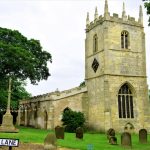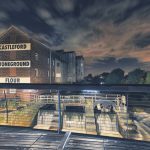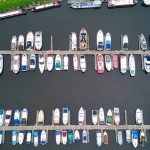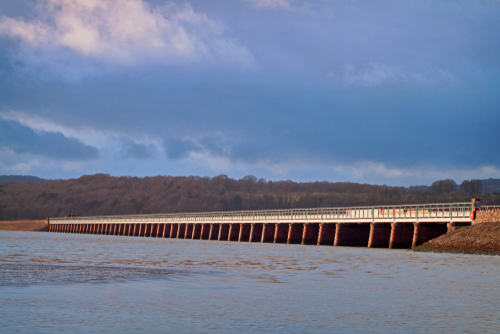
Looking for a Staycation base in the Arnside and Silverdale Area of Outstanding Natural Beauty (AONB)? Then look no further as the quaint Seaside Village of Arnside is perfectly located both for Morecambe Bay and the wider region. It is ideal if you are looking for a relaxed holiday but with enough outdoorsy things to keep you occupied. There is local history to explore, an RSPB Nature Reserve nearby and even a Wildlife Park in the vicinity. Sound Interesting? Then read on and see why we love the area so much.
Go to the Cumbria Business Directory
Where Is Arnside
Arnside is a village and civil parish in south Cumbria, Northwest England. Historically in Westmorland, it lies on the estuary of the River Kent, in the north-eastern corner of Morecambe Bay, near the border with Lancashire. The village is also within the designated Arnside and Silverdale Area of Outstanding Natural Beauty (AONB). The village is arguably most famous for its impressive rail viaduct and tidal bore. Arnside had a recorded population of 2,334, at the 2011 UK Census.
Arnside – A Fleeting History
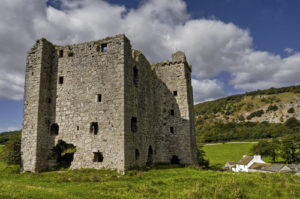
Image: Kevin Eaves/Shutterstock.com Arnside Tower dates back to 14th century
The oldest building in the parish is Arnside Tower, a Pele tower built around the end of the 14th century, one of a series situated in a ring around Morecambe Bay. The towers acted as the area’s defence against raids from Scots and the Border Reivers. Yet, by the 1840s, Arnside was still little more than a hamlet, consisting of only a few farms, fishermen’s cottages and several inns. The 1841 Census of Great Britain recorded the population of Arnside to be 140, with only 25 dwellings.
It wasn’t until 1866, that Arnside even had a church. However, by 1891, the village population had risen to some 600 people and it had more than 100 dwellings. It was the Crossfield family, who arrived in the early 19th century that was primarily responsible for the early growth of the village. The first Crossfield to move to Arnside was John, who set up a village joinery business in the village. His son, Francis developed a boat-building business, launching his first boat in 1838, whilst his elder brother, Thomas concentrated on housing building.
The Railway Reaches Arnside
In 1857, the arrival of the railway greatly improved Arnside’s transport connectivity. However, the construction of the railway line culminated in the need for a major viaduct to be built over the estuary of the River Kent. The impressive Arnside Viaduct was 1665 ft (505 m) long and had 50 piers. With the railway viaduct crossing complete, the port of Milnthorpe, which lay on the estuary was cut off. Even though changing times had seen the port in terminal decline, the railway company financed the construction of a compensatory pier at Arnside, which opened in 1860. In 1876, a branch line passenger service started up, which ran along the east side of the estuary to Kendal. The train service managed to survive until 1942.
By the mid-1880s, the Crossfield’s boat-building business was thriving and being run by brothers William, Francis, John and George, operating from the town’s ‘Top Shop’ yard. They were by this time leading builders of Morecambe Bay Prawners or ‘Lancashire Nobbies’ as they were better known. The ‘Nobbies’ were fast gaff-rigged fishing boat designed to cope with the shallow waters of the north-west coast. The railway enabled large catches of fish to be transported quickly to the industrial towns of the North West, fuelling the expansion of the local fishing industry. The Crossfield’s also built rowing boats, bay boats, and sailing dinghies, which famously included; ‘Swallow’, that owned by the famous author, Arthur Ransome. The boat was the main inspiration for his epic 1930s children’s book; ‘Swallows and Amazons’. The Crossfield’s boat-building business remained a feature of the village up until the 1950s.
WWI
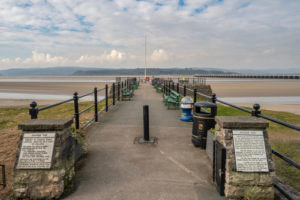
Image: Pete Stuart/Shutterstock.com Restored in 1984 -today’s Arnside Pier
In 1915, during WWI, the rail Viaduct was substantially strengthened, needed to support the much heavier trains that were now in use, transporting munitions from factories in Barrow. And, in 2010, a year-long £11 million project got underway to replace the deck of the Viaduct. The railway line closed for some 4 months during the works, but after completion of the works in July 2011, the train crossing was a much quieter and smoother experience.
In 1934, the end section of Arnside pier was destroyed in a storm but was quickly rebuilt. In 1964, the Parish Council purchased the pier, but in 1983, the structure once again sustained serious storm damage. The pier was restored in 1984 by monies partly raised through public subscription.
Arnside – The Modern Era
Arnside’s economy is increasingly reliant on tourism, now attracting around 110,000 visitors, annually. Although still modest visitor numbers by Lake District standards you’ll still find plenty of shops, art galleries, accommodation, pubs and cafes. The village also makes a great base for exploring the South Lakes.
Most visitors attracted to Arnside are nature lovers, as it offers spectacular views both across Morecambe Bay and inland towards the Lake District mountains. Its unique micro-climate also means that you’ll find an exclusive mix of flora and fauna in the area that is like no other place in the country. It has a number of perfect habitats for both plant life and wildlife, being particularly renowned for its rare butterflies and red squirrel colonies. Its thin limestone soils also make it home to a variety of rare and plants and wildflowers. If wildlife is one of your interests then Arnside as something to offer whatever the season.
The other thing for which Arnside and the surrounding area is well-known is its great number of artists and art galleries. So if you’re an art lover its well worth making a trip to Arnside as there are pretty much exhibitions on all year round in the village. The artwork on display is usually in many disciplines, ranging from paintings, jewellery, glass, printing, leather, textiles, etc.
Morecambe Bay
Morecambe Bay stretches from the south-west coast of Cumbria to Fleetwood in Lancashire, with the coastal towns of the likes of Grange-over-Sands, Morecambe and Heysham, scattered along its shores. The Leven, Kent, Keer, Lune and Wyre rivers all drain into Morecambe Bay, where their estuaries have formed a number of peninsulas. Much of the land around the bay is reclaimed, forming salt marshes used in agriculture. The Bay is also an important wildlife sanctuary, having abundant birdlife and varied marine habitats, with a bird observatory at Walney Island. Morecambe Bay is also particularly famed for its fertile cockle beds, which local fishermen have been able to take advantage of for generations.
Seven Islands!
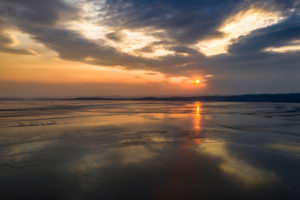
Image: Julian hodgson/Shutterstock.com Fantastic panoramic views of Morecambe Bay can be expected from Arnside
There are seven islands of note in the bay, all to the north; i.e. Walney, Barrow, Sheep, Piel, Chapel, Foulney and Roa. Walney Island, in the north-western corner of the Bay, is substantially larger than all the others. Sheep, Piel, Chapel and Foulney Islands are all tidal and some can be walked to at low tide across the sands with the appropriate care and local guidance. Roa Island is linked to the mainland by a causeway, while Barrow Island has been connected to the mainland for many years as part of the extensive docklands development at Barrow-in-Furness.
The Bay is recognised as one of the best places in the UK for many adrenalin-fuelled activities such as sailing, powered paragliding, parachuting, windsurfing, mountain biking, horseriding, and kitesurfing. It also has some of the most scenic coastlines around Britain and there a number of recognised long-distance walks and cycle routes that start in the area. These include the; ‘Way of the Roses’, a cycle route that goes all the way to Bridlington Bay, and the ‘Lancashire Coastal Way’.
A reminder, to anyone that may need it – Morecambe Bay is notorious for its quicksand and fast-moving tides! On the infamous night of 5 February 2004, at least 21 unsuspecting Chinese immigrant cockle pickers were drowned after being cut off by the incoming tides. No one should attempt to walk within the tidal range of the Bay without proper local guidance. At Arnside, sirens located at the local coastguard station, are sounded to warn of the fast incoming high tide, during daylight hours.
There has been a royal appointed, local ‘Queen’s Guide to the Sands’, since the 16th century, who is ultimately responsible for the supervision of safe crossings of the Bay. The popular 8 or 9 mile guided walks take place between May and September each year, with the times varying, depending on the tides.
What a Bore!
There are about 60 places around the world where the phenomena of a tidal bore occur – Arnside is one of them! A tidal bore occurs when the leading edge of an incoming tide, forms a wave of water that is forced up through a river estuary or narrow bay, against the direction of the flow of a river. Second to, but nothing like as famous as the Severn bore, the tidal bore at Arnside can occur in any season. The Arnside bore is fairly unpredictable but usually falls within the range of between a few centimetres up to 30 cm in height, although on occasions it has been recorded as being much higher. The bigger ‘beasts’ usually occur at the Spring and Autumn equinox, when the Morecambe Bay tides are at their highest.
Getting To Arnside
By Road
The easiest way to get to Arnside by road is via the M6. Follow the signs for Milnthorpe on the A6, from either M6 Junction 36 or 37, then head along the B5282 to Arnside.
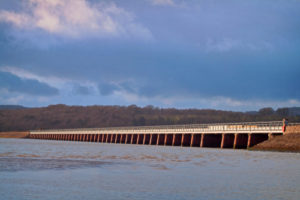
Arnside’s impressive 505m long rail viaduct over the River kent Image: DMC Photogallery /Shutterstock.com
By Train
Arnside railway station lies on the Furness Line, which runs from Barrow-in-Furness to Lancaster. Barrow is also a terminus station on the Cumbrian Coast Line which connects with multiple towns and villages through to Carlisle. Carlisle and Lancaster both lie on the West Coast Main Line (WCML) which enables direct travel to almost all parts of the country.
By Bus
If you want to get to Arnside by bus then you can take a National Express from many major UK destinations to Kendal. The village is connected to Kendal by the 551 and 552 bus services.
By Air
Manchester Airport is the nearest airport to Arnside and about a 1 hr 20 minutes journey time by car (See above; By Road).
Did you know?
- The Queen’s Guide to Morecambe Bay receives the princely annual salary of £15, although they do get the use of the 700-year-old Guide’s Cottage at Kents Bank.
- The unique temperate micro-climate around Arnside affords the existence of 15 Sites of Special Scientific Interest (SSSI) in the area.
- Arnside Knott has ‘Marilyn’ status (a small mountain akin to the Scottish Munro) but it’s officially the lowest in England.
- The Arnside and Silverdale AONB is one of England’s last remaining strongholds of the red squirrel.
Things to see and do!
• Leighton Moss Nature Reserve – owned by the RSPB, has the largest area of reedbeds in North West England and is one of the region’s most important habitat for birds. The bittern, one of the resident rare species, has been adopted as the logo of the local AONB.
• Arnside Tower – is one of a series of ‘Pele’ (defence/lookout) towers, built around Morecambe Bay and more widely throughout the border regions of England and Scotland. Built around the end of the 14th century, the towers provided refuge from the Border Reivers. Constructed of limestone rubble, Arnside Tower was originally five storeys high (50 ft). It’s the only one in the area still open to the public.
• Arnside Knott – is a hill which has an elevation of 522 ft (159 m). It lies within the South Lakeland district but it’s not in the Lake District National Park since it lies south of the River Kent. However, the land does enjoy the status of lying within the Arnside and Silverdale AONB. The ‘Knott’ is owned by the National Trust, who graze Highland cattle on it. It’s also a great vantage point for fantastic panoramic views over Morecambe Bay.
• Lakeland Wildlife Oasis – is a small zoological site about 2.5 miles from Arnside. The zoo is run by the registered charity Lakeland Trust for Natural Sciences. There are a butterfly hall and an aquarium, it also participates in a programme for breeding endangered species. In 2014, it became the first zoo to successfully breed snow leopards in the North of England. Their bespoke designed enclosure is though.
Where to stay?
There is a decent amount of available accommodation in and around Arnside, especially given the size of the village. The main type of available accommodation is either guesthouse, B&B, or small hotel. Typically, prices range from £70 to £120, per night, for 2 adults sharing. Holiday apartments are also available for those travelling in larger groups.
So there we have it our quick guide to this seaside location. If you are looking for a holiday by the sea then check our other Seaside Town guides and don’t forget to try the quiz below!
Take the Arnside Quiz!
